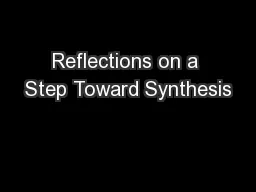

Looking across the RFU projects for some insights about what we have learned that might inform reading theory practice and policy P David Pearson UC Berkeley RFU A synthesis RFU Toward a synthesis ID: 683885
Download Presentation The PPT/PDF document "Reflections on a Step Toward Synthesis" is the property of its rightful owner. Permission is granted to download and print the materials on this web site for personal, non-commercial use only, and to display it on your personal computer provided you do not modify the materials and that you retain all copyright notices contained in the materials. By downloading content from our website, you accept the terms of this agreement.
Slide1
Reflections on a Step Toward Synthesis
Looking across the RFU projects for some insights about what we have learned that might inform reading theory, practice, and policy
P. David Pearson
UC BerkeleySlide2
RFU: A synthesis
RFU
: Toward a synthesis
RFU:
A step toward a synthesis
RFU: Reflections on a step toward a synthesisSlide3
What have we learned about
The nature of reading comprehension
The nature of its acquisition
Productive pedagogical pathways for teaching and fostering its growthWays of assessing its infrastructure, development, and applicationSome cross cutting reflections aboutEnduring challengesEnduring themes
Collateral benefitsSlide4
Nature of Reading Comprehension
Simple
RC = D x LC
Not so simpleRC = {
CoU[AxKxDis(D X LC)]}/SELCC
RC = Reading Comprehension
LC = Listening Comprehension
K = knowledge
D = Decoding and
subword
level skill
A = activity
CoU
= Contexts of Use
Dis = Discourse setting (text, genre, discourse, debate)
SELCC = Socioeconomic/
Lnguistic
/Cultural ContextSlide5
The nature of reading comprehension acquisition/development
Sub word level processes do matter
Language matters at many levels: lexical, syntactic, discourse (pragmatic level)
Curriculum matters: Activities used to engage, enact, and apply practicesTexts matterDiscussable = edgyTalk matters
Coherent, relevant, edgySlide6
The stability of performance on reading achievement measures.
SES
OR OTHER
PREDICTOR
READING COMPREHENSIONSlide7
Productive Pedagogical Pathways
Teaching it directly
Components and antecedents
Strategies and other heuristicsClose examinations of the language of text in relation to the taskSituating its development within other purposes and activitiesAcquiring knowledge within disciplines and topics
Both little kids and big kidsDebating controversial social, cultural, and ethical issuesUnderstanding, critiquing, and constructing arguments and explanations of the natural and social worlds in which we liveDeveloping cultural capital and personal identitiesBuilding on and shaping bothSupporting it with a little help from my friendsTeachers and PeersSlide8
Progress on Assessment Front
If we divide the world into
Enabling, under the hood, and reflective comprehension skills
Substantial progress on eachReading development involves the gradual automatizing of reading component skills (read enabling
and under the hood) and the incremental expansion of strategic processes (read reflective) necessary to handle the types of texts and tasks that students are expected to engage with at different ages/grades. Slide9
Enduring challenges
You really do seem to get what you pay for
Lots of proximal and few distal effects.
Things seldom travel far beyond the instructional contextTwo possibilitiesYou may have to do it all in order for any one component to “show its stuff.”
Won’t emerge if other components are weak.Does this implicate a balanced approach to reading and RC instruction?We are teaching it within a procedural rather than substantive patinaThis is how you draw an inference in general notLet’s see if we can figure this out—then name itThe strategy of the momentJust in time pedagogySlide10
Enduring challenges
Design and implementation dilemmas
Our capacity to draw inferences about constructs is constrained by the quality of our measures
Time FidelityLogistical issues: e.g., groupingTexts to match our aspirationsSlide11
Enduring themes
Some old friends continue to show up
Vocabulary
Traversing the stuff of human experienceSome new friendsSyntax The discourse of complex reasoningSlide12
Policy Possibilities
Extending teaching reading beyond grade 5 or beyond grade 8
Not every teacher is a teacher of reading
Every teacher has both an obligation and an opportunityObligation to understand how reading (and writing and language) can make or break the acquisition of disciplinary knowledge and inquiry practicesOpportunity to use reading, writing and language to support not supplant disciplinary learning
Putting assessment in its place: two possibilitiesAs long as people are going to teach to the test, let’s have tests worth teaching toNever send a test out to do a curriculum’s jobCurriculum-driven assessment not test driven curriculumSlide13
Policy Possibilities
A different stance toward enabling skills
Enablers are just that.
The job of phonics isn’t done until kids learn how to critique the subtext of the texts they encounterSlide14
Collateral Benefits: A Serendipitous Legacy
Someone should do a monograph highlighting those contributions
Refined applications of the very latest in research methods
Applications of the latest in Research and statistical designs and analysesMeasuring fidelity and dosage
Iterative design-based workIncredibly well-designed pedagogical programsIntegrating components documented in more focused studies Many many useful assessmentsSlide15
An agenda for the future
Building on snapshots of promise in RFU
The affective face of learning
Engagement RelevanceChoiceSelf-efficacyIdentity
Cultural capital KnowledgeCapitalizing on the synergies for reading, writing, and languageThe role of talk in promoting reading comprehension.Slide16
An agenda for the future
New issues and enterprises
The digital world of text (acknowledging GISA)
Global contexts for engaging reading, writing, and languageSlide17
Taking Stock
What do
we know now that we did not know before?Slide18Slide19
Thank yous
To IES for funding all of this work!
To the various RFUs for advancing our knowledge about the core of this thing called reading!